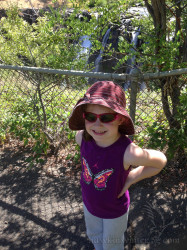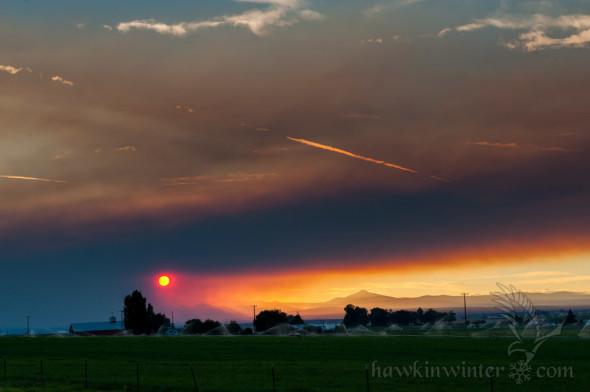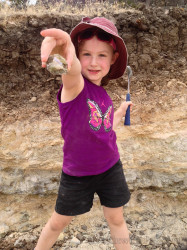 My five-year-old daughter has been very interested in rocks, crystals, and minerals lately, an offshoot of her intense interest in faeries and the natural realm over which they preside. At her request, I pulled up several images from Google displaying a variety of agates, jasper, geodes and, of course, thunder eggs. This led to a short hike to a nearby creek, after which she discovered several examples of quartz and red agates polished by the stream. By the time this trip had ended, a new pebble puppy was born and my inner rockhound had been reawakened.
My five-year-old daughter has been very interested in rocks, crystals, and minerals lately, an offshoot of her intense interest in faeries and the natural realm over which they preside. At her request, I pulled up several images from Google displaying a variety of agates, jasper, geodes and, of course, thunder eggs. This led to a short hike to a nearby creek, after which she discovered several examples of quartz and red agates polished by the stream. By the time this trip had ended, a new pebble puppy was born and my inner rockhound had been reawakened.
We happen to live in a very geologically active area and a perfect breeding ground for all sorts of beautiful minerals awaiting discovery. The Pacific Northwest is home to a family of volcanoes in the Cascade Range. Over millennia they would belch ash rich in silica on to the desert planes. This silica rich volcanic ash, known as ryolite, accumulated and eroded forming striking reddish cliffs that enhance the otherwise monotonous desert landscape. The silica, being water soluble, percolated through the porous rock, eventually settling in gas-evacuated hollow spaces of the hardened basalt. Over time this material solidified, forming the colorful agate centers of what we now call thunder eggs. With such rich geology a stone’s throw away we planned a family trip to mine some eggs and start an epic rock collection. A few rock hammer purchases later and we were on our way.
White River Falls State Park
We broke up the three hour drive (eternity to a toddler) with a short stop at the White River Falls, a majestic cascade located near the Deschutes River. Originally the site of a hydroelectric plant built in 1910, the waterfall is now a part of a state park and an excellent summer recreation spot. With temperatures approaching 95 degrees Fahrenheit, a downstream swim would have been welcomed but we simply didn’t have the time. Instead we stayed long enough to snap a few photos before moving on. This is definitely a spot that we’ll return to in the near future.
The Road to Madras
After our stop at the falls we headed south toward Madras. A recent summer electrical storm ignited multiple fires that set the Cascade forests ablaze, filling the skies with amber smoke. Before we left, I spent some time on Sky Vector and noticed a number of TFRs (temporary flight restrictions) surrounding our intended destination. From this map I knew that we’d probably be inhaling more than a lungful of incinerated fir trees.

Camping… Kamping… Glamping at the KOA
We were hoping the winds aloft would carry the clouds to the north but we arrived at a campsite enveloped with a yellow choking cloud. This was our first time staying at a KOA (Madras/Culver KOA), and we were surprised that this particular KOA was an attraction in itself. This part of the Oregon desert is famous for rockhounding, so the KOA set aside a small rock garden with polished agates for their younger guests to find. This coupled with a swimming pool, playground, ice cream social and after-dark glow parade made the kids not want to leave. We stayed in a “kabin” which was a definite upgrade from a tent. I don’t feel the least bit guilty about glamorous camping since I did plenty of “real camping” in the Boy Scouts. 
Richardson’s Rock Ranch
 Richardson’s Rock Ranch is a 17,000 acre ranch built right on top of numerous agate beds and petrified wood. After arriving at their rock shop, a short drive from Madras, we registered and received directions to find the agate beds. We learned that the first agates were retrieved here in the 20s and since then more thunder egg sites were located and excavated. I can only imagine how many more thunder eggs and geodes are waiting to be discovered given that this geologically rich area has been providing a steady flow of thunder eggs for almost one hundred years.
Richardson’s Rock Ranch is a 17,000 acre ranch built right on top of numerous agate beds and petrified wood. After arriving at their rock shop, a short drive from Madras, we registered and received directions to find the agate beds. We learned that the first agates were retrieved here in the 20s and since then more thunder egg sites were located and excavated. I can only imagine how many more thunder eggs and geodes are waiting to be discovered given that this geologically rich area has been providing a steady flow of thunder eggs for almost one hundred years.
The drive to the agate beds took about 25 minutes, following a dirt road across cattle pastures toward the rhyolite ridge-lines to the East. We arrived with a bucket and two shiny new Estwing rock hammers which we immediately put to work. I discovered my first egg within minutes and I soon had enough to fill half my bucket. The eggs were found at the base of an excavated wall with clearly delineated layers: top soil, then gravel, and finally a decayed rhyolite clay containing the eggs. I was surprised at how delicate the eggs were with some disintegrating as they were gently dislodged. I found my top ten and then helped my daughter to unearth the treasures she found. My one-year-old son played in the dirt with a perpetual smile.
Thunder Eggs!
We mined around 30 eggs in all, weighing 32 pounds. Of these we had about half cut and from those that we cut all but two yielded a beautiful agate center. I learned that thunder eggs with a visible hole will most likely crumble under the saw and are not good candidates for cutting. When we return to the agate beds, we’ll be much more selective about what we take back for cutting. While thunder egg hunting is the primary draw, Richardson’s Rock Shop is just as exciting. This shop has been open every day for the past forty years and includes a museum in addition to a very impressive inventory. We spent an hour here while we waited for our rocks to be cut and it certainly wasn’t a difficult wait!































